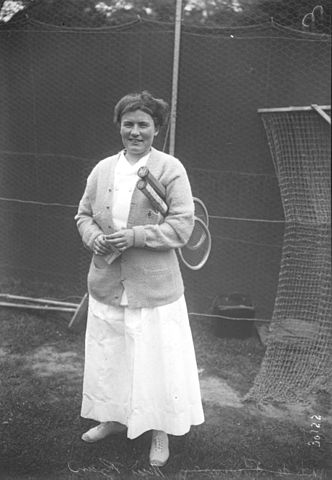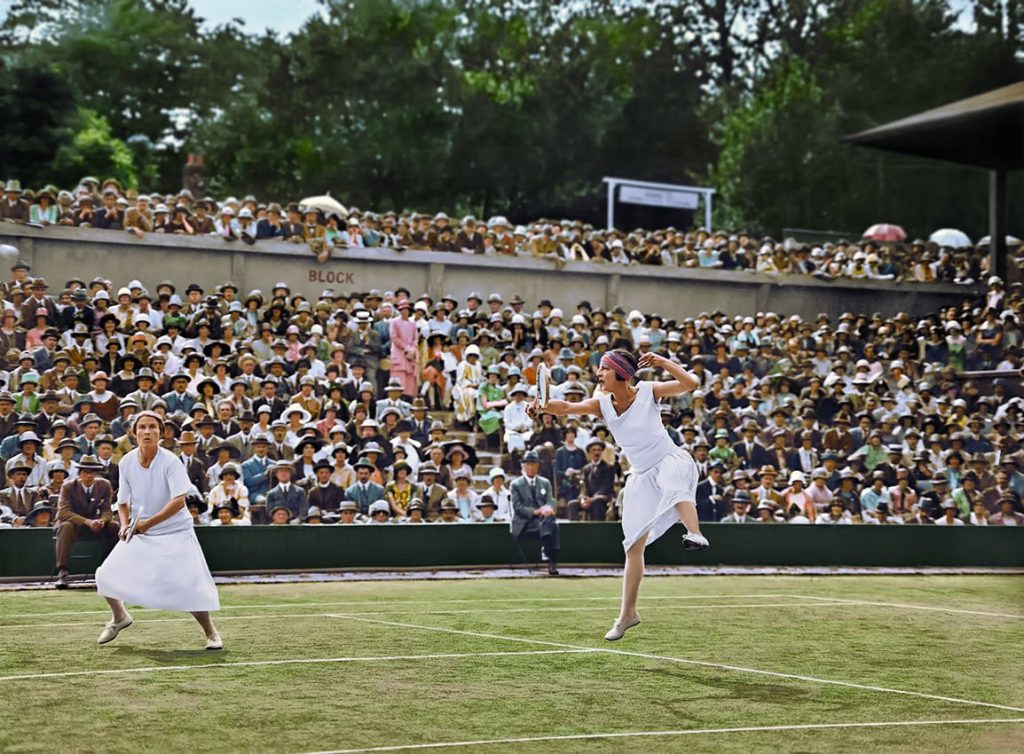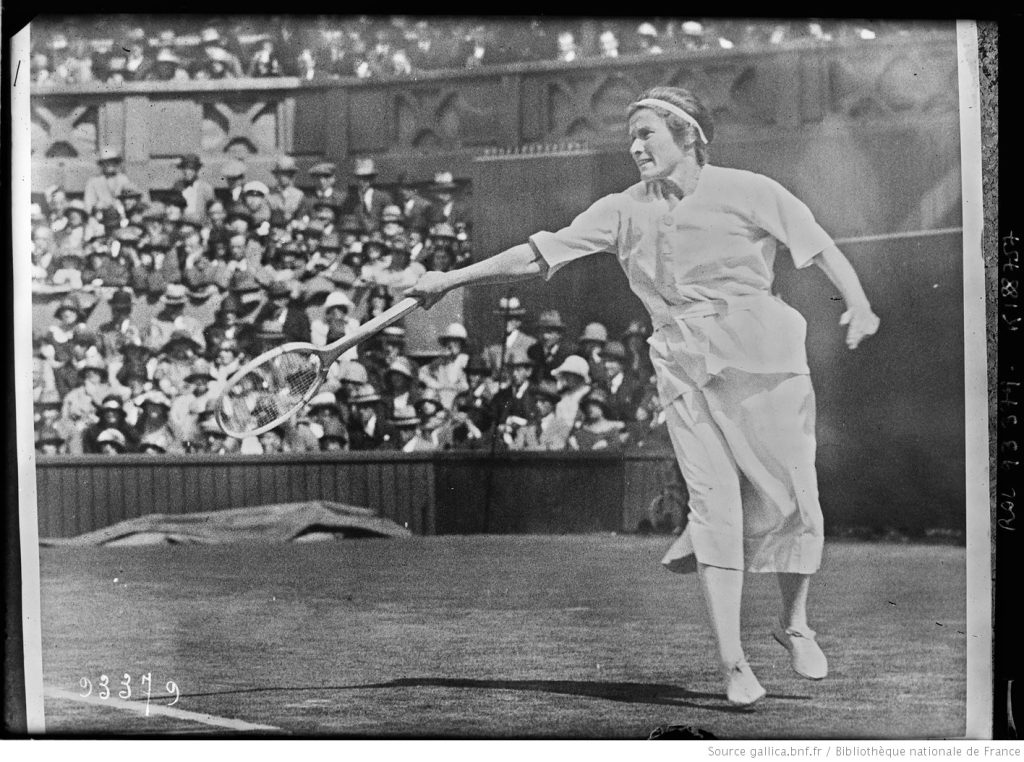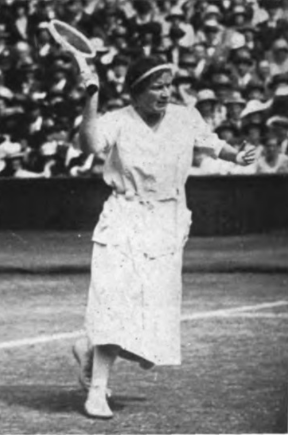In 2022, I’m counting down the 128 best players of the last century. With luck, we’ll get to #1 in December. Enjoy!
* * *
Elizabeth Ryan [USA]Born: 5 February 1892
Died: 6 July 1979
Career: 1905-34
Played: Right-handed (one-handed backhand)
Peak rank: 3 (1927)
Major singles titles: 0
Total singles titles: 214 (at least)
* * *
Six hundred and fifty nine.
According to Elizabeth Ryan’s obituary in the New York Times, that’s how many tournaments she won–singles, doubles, and mixed doubles–in a 19-year span.
Yes. Six hundred and fifty nine. Thirty five per year for almost two decades.
Most women would be lucky to win so many matches at the top level of competitive tennis. Among active players, only Serena Williams, Venus Williams, and Svetlana Kuznetsova have tallied that many singles victories, and only a few more have amassed as many across all disciplines. Ryan–“Bunny” to her friends and “Bouny” to doubles partner Suzanne Lenglen–won that number of championships. The resulting haul of trophies and commemorative knickknacks was enough, one wag wrote, to stretch from her adopted home in London all the way back to New York.
Here’s the thing–659 probably isn’t even the complete list. Another source says 662, and when a researcher at tennisforum.com went in search of the full list, he identified 568 of them with five seasons left to finish. What’s more, while the Times assigned the 659 titles to a 19-year span, Ryan collected hardware for nearly three decades. She won her first tournaments in 1906, and she might have snagged a doubles trophy in 1905, when she was 13 years old. She was still occasionally coming out on top in 1934, her last season as an amateur.
When she turned pro–to teach, since she needed to earn a living–a journalist estimated that she had reached 1,500 finals. That’s probably a bit high: Bud Collins came up with a list of 365 tournament entries, and some events didn’t include both women’s doubles and mixed doubles draws. But four digits is within the realm of possibility.
We do have some concrete numbers. Wimbledon historian Alan Little has made a careful study of tournaments on the French Riviera, where she was a “terror” to the rest of the field. On that winter circuit alone, Ryan won 251 titles: 73 singles, 99 doubles, and 79 mixed. Separately, I’ve come up with a list of 214 singles titles (including those Riviera victories), which don’t yet include tournaments from before the war.
So it’s safe to say that 659 is a lower bound. We’ll never know exactly how many competitive matches Elizabeth Ryan won, but it’s well into the thousands. It’s probably more than any other woman in the history of the sport.
* * *
The first thing that many people noticed about Bunny Ryan was her eyes. Greyish-green in color, or perhaps bluish-grey, they were “perpetually in a twinkle” when she was off the court, according to journalist John Tunis.
Behind the twinkle, Tunis saw “a reserve of mental power.” On court, her eyes revealed her determination. Under pressure, you could watch as she became even more focused.
By the time Tunis profiled her for the New Yorker in 1925, she had won ten Wimbledon titles: seven in women’s doubles, three in mixed. She was 33 years old. She had been born in California and learned her tennis on the asphalt courts there, but she had spent most of her adult life in Europe after her sister, Alice, married an Englishman. In 1917, she wrote on an American passport application, “I cannot state definitely, but I do intend to return.”

The occasion for the New Yorker piece was Ryan’s long-awaited return. She had played Wimbledon since 1912, and oddly enough, she had even managed to enter the French Championships in 1913, before it was open to foreigners. (She and a handful of other overseas players probably got in thanks to membership in a French club.) But only in 1925 would she make her first appearance at Forest Hills.
The American press coverage of Ryan is revealing. She is remembered now as a doubles specialist–the doubles specialist of the era–but she was nearly as dangerous on the singles court. Tunis, among others, saw her as the favorite for the US national title, even in a field with defending champion Helen Wills and 1924 Wimbledon titlist Kitty Godfree.
Bunny helped her own case in her very first American tournament in more than a decade. At Seabright, the traditional Forest Hills warm-up on the New Jersey coast, she needed only 40 minutes to dispatch Wills in the final, 6-3, 6-3. Wills hadn’t lost a match since the Wimbledon final the year before, but on the damp grass, Ryan’s forehand chops and imperturbable volleying were too much. Bunny struggled on the faster turf at Forest Hills and lost to Godfree in the quarters. Yet all told, the American trip boosted her reputation even further.
* * *
It was impossible to follow tennis in the mid-1920s and not recognize Ryan’s prowess. If you were the sort of person to scan each week’s results in your favorite tennis periodical, you’d see her name so often you might wonder if there were two players named E. Ryan.
In 1924, the year before she made her triumphant return to the States, Bunny played a jaw-dropping schedule. She entered 36 tournaments a 43-week span between Christmas of 1923 and mid-October the following year. She played every single week for five months starting in mid-May. The closest thing she got to a break was the second week of Wimbledon where, uncharacteristically, she didn’t make any of the finals.
I want to give you a taste of how a player could possibly amass 659 (or more) titles over her career, and a look at her 1924 campaign is the perfect way to do it. You might want to skip ahead to the next section, though. Bunny’s schedule is exhausting just to read about.
She started her season in Monte Carlo at Christmastime. She went on to play 14 straight weeks on the Riviera, winning nine singles titles, ten in women’s doubles, and five in mixed. In four of the tournaments where she didn’t win the mixed, she lost to Lenglen in the final; twice, the victorious team was Lenglen and Henri Cochet. Still, when Lenglen paired the Swiss champion Charles Aeschlimann, Ryan was considered the best player on court. She pushed Suzanne’s team to 15-13 in a deciding set.*
* Bunny’s partner that week was the Canadian Henry Mayes, but I get the sense that it hardly mattered.
After a few weeks off, Bunny played the British Hard Court Championships, where she won all three titles. It was her fourth “triple” of the year–a single week with victories in singles, doubles, and mixed–and it was only April.
Another few weeks, and the real work began. Ryan played six straight weeks before Wimbledon, winning five singles titles, including a triple at the “Gipsy” Club in North London. Her only singles loss was a final against Godfree.

Colorization credit: Women’s Tennis Colorizations
Wimbledon was a letdown: not even a semi-final in three events. But in a way, it was her most impressive performance of the season. She met Lenglen, her doubles partner, in the singles quarter-finals. Ryan took the second set from the great Suzanne, 8-6. It was the first set Lenglen had lost since her Forest Hills defeat at the hands of Molla Mallory in 1921. Toward the end of the lost set, Lenglen was visibly imploring her father to let her default. He encouraged her to press on, and she won the final set, 6-4.
But the damage was done, possibly to Lenglen’s health, and definitely to her fragile nerves. She withdrew from the tournament, leaving Ryan a loser by default in the doubles quarter-finals. She and Randolph Lycett had lost early in the mixed, so for the first time in more than a decade, Bunny was absent from all three finals.
She made up for it with a vengeance. Here’s what she did for the next seven weeks:
- Welsh Championships: Triple
- Nottinghamshire Championships: Triple
- Midland Counties Championships: Triple
- Shanklin: Triple
- Sandown: Triple
- Worthing: Triple
- West Sussex Championships: Triple
Add singles and women’s doubles titles in Budleigh Salterton the week after that (she lost the mixed final in three sets), and that’s 23 championships in less than two months.
All told, Ryan won 72 titles in her 36 tournaments between December of 1923 and October of 1924. It could be even more than that. We don’t have doubles results for every one of the events, though in some cases it’s because none were played. In singles alone, she tallied 129 wins against 7 losses.
Bunny won 15 triples, and of the three dozen tournaments she entered, she won at least one title at 33 of them. Even the shutouts make her record sound impressive. One week on the Riviera in February, she pulled out of all three with a bad cold. At the Middlesex Championships in May, she reached all three finals (beating Mallory in singles), but lost two of the title matches to Godfree. And at Wimbledon, she nearly beat Suzanne, indirectly knocking herself out of the women’s doubles. Under any other circumstances, the five-time defending champions would have won easily.
You start to see how she got to 659.
* * *
Ryan was not the first woman to master the volley. But in a field made up mostly of baseliners, she was one of the first great net players, and probably the best of them all, at least until Alice Marble reached her peak in the late 1930s. Tunis called her “a master of her art.”
Bunny was dominant at net, and she made it a point to get there quickly. American Lawn Tennis sketched her playing style in 1923:
It is hard to imagine her on the defensive because she rarely allows herself to get into such a situation, and, when in, gets out of it as quickly as possible. Her strokes are all aggressive except a safe back court chop, which she employs only when forced to take drives from the base line.
The “chop” was once much more common. Struck with heavy underspin, it was sometimes a dropshot, sometimes hit deep, and always–at least to the modern sensibility–very annoying.* Ryan was sometimes known as “Miss Chop and Drop,” and her forehand chop was the stuff of nightmares, especially on slow grass. She used the chop to upset Helen Wills at Seabright in 1925, and she repeated the feat, with the loss of only five games, a year later.
* The hard-hitting Molla Mallory wrote in her 1916 instructional book, “The player with a great repertoire of cuts [chops] may disconcert an opponent for the time being, but so would a server who turned a somersault on her delivery.” Bunny and Molla were not friends.
Unfortunately, her chops weren’t as steady as her net play, and the lack of a reliable baseline game kept Bunny from ever winning a major singles title. Part of the problem was that, despite her killing schedule, she just didn’t play that many majors. Aside from her 16 appearances at Wimbledon, she played the French seven times and the US championships three times. All of the non-Wimbledon entries came after her 33rd birthday.
She also had the bad timing of playing her tennis during the Lenglen years. Three times at Wimbledon, she gave Suzanne an unaccustomed challenge, particularly in the 1919 semi-final, when they met for the first time. But the Frenchwoman won them all. Bunny had her best chance at a major title at Forest Hills in 1926, when Wills was absent. Ryan faced Mallory in the final, and built a 4-0 lead in the decider, even reaching double match point at 5-1, 40-15. But Molla came alive, and in the words of Allison Danzig, Bunny “wilted before the devastating attack.”
Ryan would come close one more time. At age 38, she beat Betty Nuthall and Cilly Aussem to reach the Wimbledon final. On dry turf, she had little chance against Wills (by then Helen Wills Moody), and she went down to a quick defeat, 6-2, 6-2.
* * *
The Elizabeth Ryan story that pops up most often in the history books is an ambiguous one. For decades, Bunny held the record for most Wimbledon titles: 19, comprising 12 women’s doubles and 7 mixed. When Billie Jean King closed in on the mark in the late 1970s, Ryan was still alive. She continued to make annual appearances at the All-England Club.
She clearly had mixed feelings about losing the record. She was reported to have said, “I hope I don’t live to see my record broken, but if someone is to break it, I hope it is Billie Jean.” But she refused to do a joint interview with King when Bud Collins requested it, and Billie Jean found her unfriendly.
In 1979, King finally won her 20th Wimbledon crown, a women’s doubles championship alongside Martina Navratilova. Bunny never saw it. The day before, she collapsed on the tournament grounds after the men’s doubles final, and she died.
It’s a shame that the amateur-era tennis record book has always been so spotty. Yes, Ryan could always point to her remarkable feats at Wimbledon, and she surely knew that her three-decade career had few parallels. But when Billie Jean overtook her most famous mark, Bunny lost her most notable claim to fame. It was the one solo accomplishment that confirmed her as so much more than just Lenglen’s doubles partner.
Even though we don’t always know the exact numbers, there are many more categories in which Ryan stands alone. No one won more Riviera titles than she did. Her 72 (or more) tournament victories in 1924 surely tops the single-season list.
And those 659 career titles? With better record-keeping, it’s a number that every tennis fan would know. No woman has come close in the last ninety years, and Bunny’s name will surely hold pride of place for the next nine decades, too.

